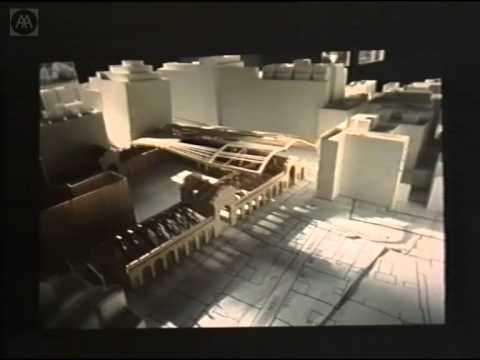
Lecture date: 1998-05-19
Begun over twelve years ago the Igualada Park-Cemetery in Catalonia is a founding project for Enric Miralles. For Miralles, a cemetery is not a tomb but a relationship with the landscape and forgetting . . . memories are deposited in the fissures of the tombs, the vegetation fills the empty spaces of the embankment, and the shadows begin to act as a clock. In this lecture he talks about Igualada and reviews work relating to recent projects.
NB: Occasional audio crackle.
Mohsen Mostafavi introduces Enric Miralles.
ENRIC MIRALLES: Thank you for having the patience for inviting me again. My lecture was named Alphabets and Shadows or something like that, in a way, it is because I am preparing a kind of publication, but in a way when you review your work… I like to present the work not as a kind of hypothesis and then you give the building as the answer; I prefer to work in a kind of continuous work and the best way to express new work is by expressing the freedom you have at the moment you make decisions in between doubts. I’m going to talk about this, sorry, but I think it makes sense in a school, because you are fundamentally safe, because one day the academic term finished: whatever you have is the result. This is the slight difference: not having any final result, even knowing that the building process is just one step in time, one day it will have its own life, etc. I was quite impress when I decided to take this kind of shadows, maybe you’ve seen some of the photos: photographing your buildings as anything you want to see in them instead of the building itself. I’m going to show you two projects on which we are working now, in the intermediate moment we are in the office, developed as a necessity, when I was talking about site. This is impressive, because now most of the work we are doing has to do with restoration, with urban sites that are being demolished, a lot of European cities are being like that: reusing, doing it again, taking any little detail as a starting point. Gideon’s ‘Space, Time and Architecture’… this famous word time, that I really never understood, what does it really mean, I think he has not understood much either, because it sounds nice, but you don’t really know. Doing this projects you find how much time exceeds something material, I think, time is the place of some architecture, when you have no land. When you are in a urban context, all of the buildings exist, there is expectations about construction, about new forms, and then you have the feeling that time is what is more important. I have two slides missing that are quite important, but I will draw them. What is impressive of a Miró painting, or some of them… probably for me he is one of the painters who have been more material, when you read Miró’s notes, they are impressive, because they say: “I’m going to do something in which I’m going to use a lot of white, maybe some piece of wood and then I will do three tries.” And this is the program of his painting, and then, of course, he starts doing some other things and talking about something else. If you look carefully at a Miró painting, there are two things, how he prepares the canvas for that to exist, and the second thing [takes a piece of chalk and he is about to draw] is this… sorry for copying a Miró, but there is… [audience laughter]. There is a fear, I would say I start most of my projects with this painting, which I never did. There is something which is amazing, which is—I think this is one of the best forms, I mean, with this you could pass most of the exams, I’m sure, really, it’s useful for almost anything—I’m really impressed because it’s so precise, what I like about this is—I was talking about things like this thinking more in Giacometti. My trace is the one of the architect, very bad, but if you see how many tries exist behind that, until this form is fixed and how he connected it with some other one and then how he calibrated the distance to a third piece, this for instance is impressive, how the triangle finished into something, and then how he defines a distance, as if saying, “here, nothing else will happen,” and then he goes back, and almost like a joke tells you that he is very conscious of the humoristic quality of this, and makes it as some kind of burnt sun, or whatever, and then in an amazing way he starts a much more subtle way. I’m impressed of how he establishes the relationship between the things and how everything is meaningful and how he creates the sort of relations that in the final result exist, let’s say, all the thousands of tries, where the forms become something, I would say, as precise as my other illustration [shows from his notebook] this is more difficult to draw, i hope you see it from here. It’s a double portrait, this was a tradition